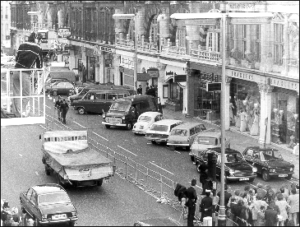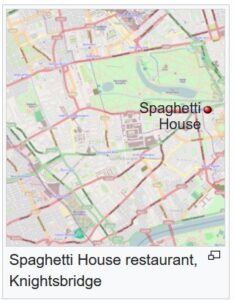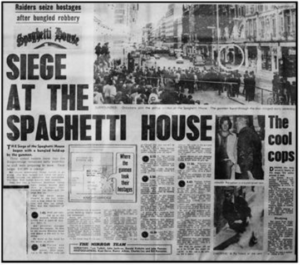 Often when a robbery goes wrong, the would-be robbers decide that the best way out of the situation is to take hostages. The hope is to negotiate a way out of their pending imprisonment. Most hostage takings or sieges last a few hours but on September 28, 1975, The Spaghetti House siege began, and it continued until October 3, 1975. The Spaghetti House was a restaurant in Knightsbridge, London, and when the robbery went wrong, the police were on the scene so quickly that the robbers couldn’t get away. Seeing that they were trapped, the three robbers took the staff down into a storeroom and barricaded themselves in. The three robbers had been involved in black liberation organizations and tried to set the robbery as being politically motivated, thinking that a political standoff might have a better chance of success. The police did not believe them, however, and they stated that this was no more than a criminal act. Finally, they decided that the political ploy was not going to work, so the robbers released all the hostages unharmed after six days. I can’t say for sure that this was the longest robbery siege in history, but if it wasn’t, it ranked right up there. Finally, two of the gunmen gave themselves up, while the ringleader, Franklin Davies, shot himself in the stomach. He survived, and all three were later imprisoned, as were two accomplices. To keep tabs on the situation during the siege, the police used fiber optic camera technology, giving them live surveillance. They monitored the actions and conversations of the gunmen from the audio and visual output. They brought in a forensic psychiatrist to watch the feed and advise the police on the state of the men’s minds, and how to best manage the ongoing negotiations.
Often when a robbery goes wrong, the would-be robbers decide that the best way out of the situation is to take hostages. The hope is to negotiate a way out of their pending imprisonment. Most hostage takings or sieges last a few hours but on September 28, 1975, The Spaghetti House siege began, and it continued until October 3, 1975. The Spaghetti House was a restaurant in Knightsbridge, London, and when the robbery went wrong, the police were on the scene so quickly that the robbers couldn’t get away. Seeing that they were trapped, the three robbers took the staff down into a storeroom and barricaded themselves in. The three robbers had been involved in black liberation organizations and tried to set the robbery as being politically motivated, thinking that a political standoff might have a better chance of success. The police did not believe them, however, and they stated that this was no more than a criminal act. Finally, they decided that the political ploy was not going to work, so the robbers released all the hostages unharmed after six days. I can’t say for sure that this was the longest robbery siege in history, but if it wasn’t, it ranked right up there. Finally, two of the gunmen gave themselves up, while the ringleader, Franklin Davies, shot himself in the stomach. He survived, and all three were later imprisoned, as were two accomplices. To keep tabs on the situation during the siege, the police used fiber optic camera technology, giving them live surveillance. They monitored the actions and conversations of the gunmen from the audio and visual output. They brought in a forensic psychiatrist to watch the feed and advise the police on the state of the men’s minds, and how to best manage the ongoing negotiations.
There were a number of things that potentially led up to the robbery, not that these things were in any way a good excuse. Post-World War II Britain had a shortage of labor. Due to that shortage, the British decided to bring in workers from the British Empire and Commonwealth countries. These people came from poverty areas,  and while they were placed in low-pay, low-skill employment, which forced them to live in poor housing, it probably wasn’t much different than what they came from. Nevertheless, economic circumstances and what were seen by many in the black communities as racist policies applied by the British government, just like in other nations. This led to a rise in militancy, particularly among the West Indian community. The people grew angry, and their feelings were exacerbated by police harassment and discrimination in the education sector. The director of the Institute of Race Relations in the mid-1970s, Ambalavaner Sivanandan said that while the first generation had become partly assimilated into British society, the second generation were increasingly rebellious. These robbers were a part of that second generation.
and while they were placed in low-pay, low-skill employment, which forced them to live in poor housing, it probably wasn’t much different than what they came from. Nevertheless, economic circumstances and what were seen by many in the black communities as racist policies applied by the British government, just like in other nations. This led to a rise in militancy, particularly among the West Indian community. The people grew angry, and their feelings were exacerbated by police harassment and discrimination in the education sector. The director of the Institute of Race Relations in the mid-1970s, Ambalavaner Sivanandan said that while the first generation had become partly assimilated into British society, the second generation were increasingly rebellious. These robbers were a part of that second generation.
The ringleader, Franklin Davies was a 28-year-old Nigerian student who had previously served time in prison for armed robbery. The two men with him were Wesley Dick (later known as Shujaa Moshesh), who was a 24-year-old West Indian; and Anthony “Bonsu” Munroe, a 22-year-old Guyanese. The men were all involved in black liberation organizations at one time or another. Davies had tried to enlist in the guerrilla armies of Zimbabwe African National Union and FRELIMO in Africa. While Munroe had links to the Black Power movement. Dick was an attendee at meetings of the Black Panthers, the Black Liberation Front (BLF), the Fasimba, and the Black Unity and Freedom Party. He regularly visited the offices of the Institute of Race Relations to volunteer and access their library. Sivanandan and the historian Rob Waters identify that the three men were attempting to obtain money to “finance black supplementary schools and support African liberation struggles.”
By the mid-1970s the branch managers started a weekly tradition of closing the London-based Spaghetti House restaurant chain to meet at the company’s Knightsbridge branch. During that time, the outlet would be closed, but managers would deposit the week’s takings there, before it was paid into a night safe at a nearby bank. Of course, that was a well-known fact. So, at approximately 1:30am on Sunday, September 28, 1975, Davies, Moshesh, and Munroe entered the Knightsbridge branch of the Spaghetti House. One carried a sawed-off shotgun, and the others had handguns. The three men burst in and demanded the week’s takings from the chain, which was between £11,000 and £13,000. The restaurant was dimly lit, and it gave the staff a chance to  hide the briefcases of money under the tables. Now infuriated, the three men forced the staff down into the back, but the company’s general manager managed to escape out the rear fire escape.
hide the briefcases of money under the tables. Now infuriated, the three men forced the staff down into the back, but the company’s general manager managed to escape out the rear fire escape.
He quickly called the Metropolitan Police, who were at the scene within minutes. The getaway driver, Samuel Addison, realized that the plan was going wrong, so he decided that it was every man for himself, and drove off in a stolen Ford. The police entered the ground floor, so Davies and his colleagues forced the staff into a rear storeroom measuring 14 by 10 feet, locked the door, barricaded it with beer kegs. They began shouting at the police that they would shoot if they approached the door. The police surrounded the building, and the siege began. It would finally end on October 3, 1975, with the surrender of the robbers, and later the location and arrest of the two accomplices.
.


Leave a Reply